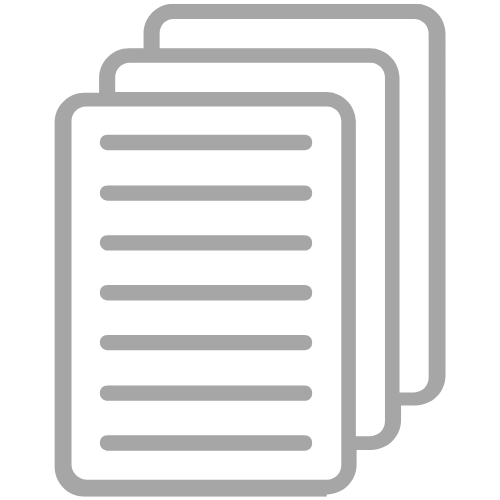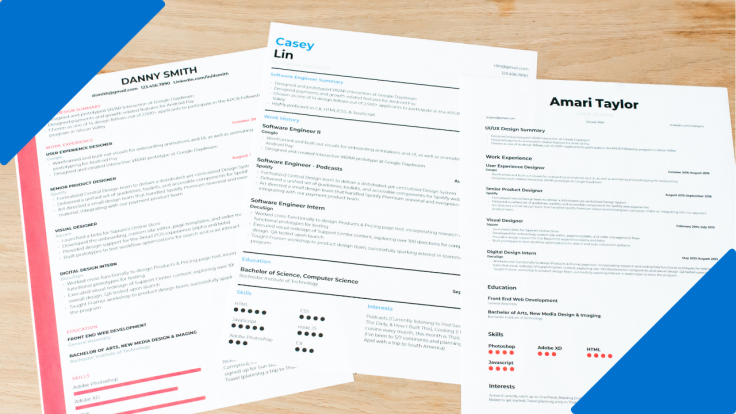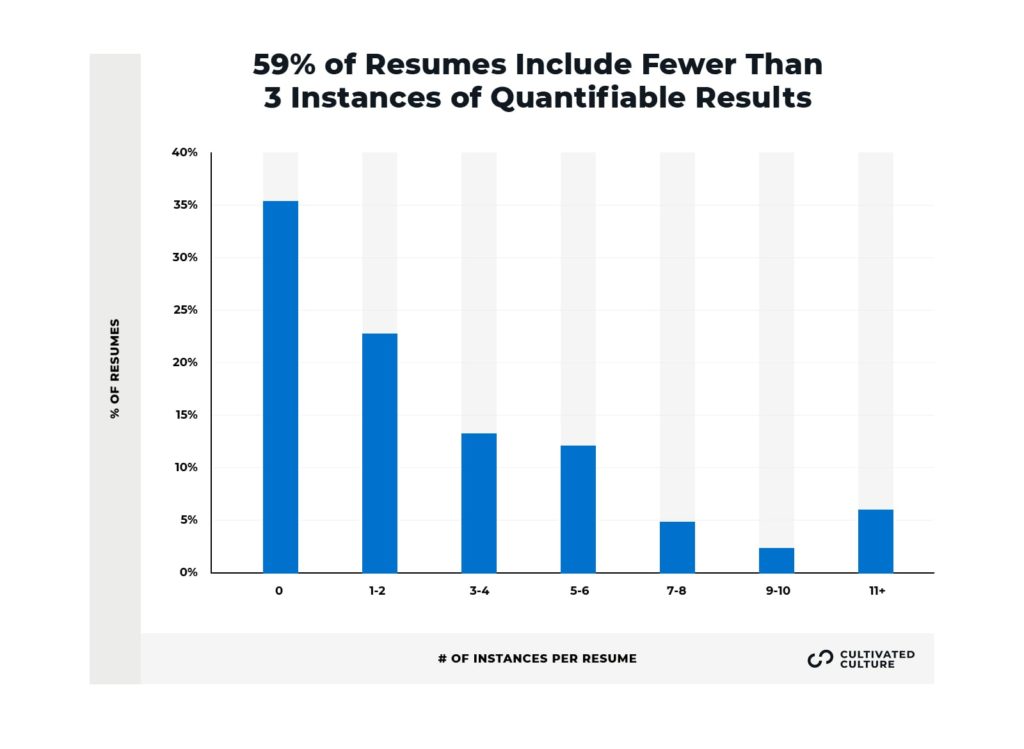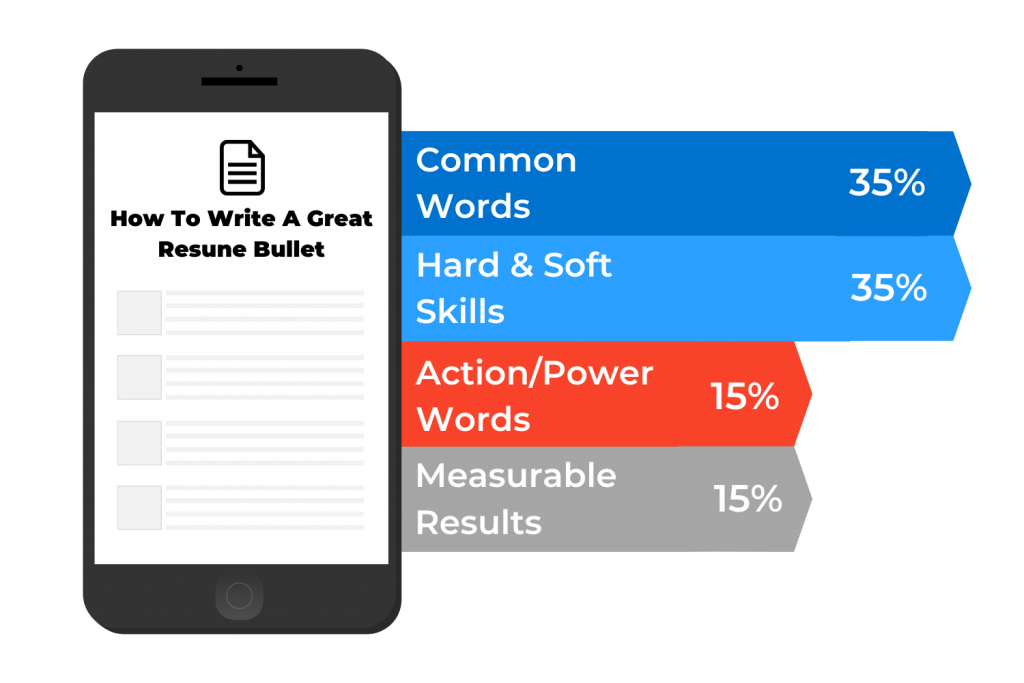As someone coming from a journalism background, I've done my share of writing press releases. The number #1 strategy I used to get media coverage?
Numbers.
Not only are numbers a good way to measure the impact of the information you are sharing, but it also pops right out of the screen, making it easy to scan and more likely to read.
The same thing happens with your resume.
Using metrics and numbers is a well-known best practice for illustrating and selling value. And yet, only 26% of resumes include at least 5 instances of measurable results, metrics, or value. On the other hand, 36% of resumes have zero instances of metrics.
If you want to win more interviews, then your resume needs metrics!
But, I know…
Finding metrics can be a struggle, especially if you're not coming from, say, a Sales or Marketing background where numbers are commonly featured as KPIs.
But the good news is: anyone can leverage measurable results in their resumes.
5 Resume Metrics Anyone Can Leverage
Seriously. Any role can have measurable outcomes tied to its actions. Here are a few prompts to help you uncover them!
#1 Time-Based Metrics
Time-based resume metrics are super relevant and can be used in nearly every role.
Think about a project you were involved with that rolled out quicker than you expected.
- How long did it take you to achieve a specific goal?
- Was that faster than usual or ahead of the timeline?
- If so, by how much?
Once you've come up with those answers, wrap it up in a compelling bullet point!
For example, suppose you are an elementary school teacher and you've been organizing PTA meetings for the last year. You noticed meetings could wrap up quicker if parents received meeting minutes before each conference, so you started e-mailing them the topics one day before each encounter. Your initiative dropped PTA meeting durations from 1 hour to 45 minutes.
Here's how you could craft your resume bullet:
“Reduced parent-teacher conference durations by 25% while maintaining thorough communication.”
Much better than your ordinary “Responsible for organizing PTA meetings“, right? Plus it shows employers you care for increasing efficiency — skills many recruiters look for in new hires.
#2 Scope Of Contributions
You can also leverage your scope to bring in measurable results in your resume. You can mention things like:
- The number of people you managed
- Number of users on the product you worked for
- Budget for a specific project
- And so on!
For example, let's say you've worked as a nurse and helped train new staff members every quarter.
Here's how you could write a compelling resume bullet with measurable results:
“Led quarterly training for 20+ new staff members, improving patient care by 36% through effective team management.”
This way, employers know you are capable of effectively communicating and mentoring a large group of new team members, which says a lot about your leadership skills.
#3 Efficiency And Productivity
Focusing on efficiency and productivity metrics is a great way to show what you bring to the table in any role.
Here are a few ideas of what you could showcase on your resume:
- Cost reductions
- Time-saving
- Improved outcomes
For example, if you are working in an executive assistant role helping manage office supply purchases, you could go with something like:
“Reduced office supply costs by 20% by negotiating with vendors.”
This shows employers your organizational and management skills!
#4 Comparisons To Show Growth
Comparing your results to the past is a great way to show employers what you can bring in for the role.
When thinking about how you can quantify and compare your results to previous work, consider things like:
- Time: Did you do things faster?
- Quality: Did your work improve outcomes?
For example, an accountant working on tax returns could have something like:
“IIncreased tax return accuracy by 35%, reducing audits and enhancing compliance by 15% through data analysis.”
Employers like to see comparisons because they show candidate's problem-solving and innovative skills.
#5 Feedback From Stakeholders
Still got nothing? Fear not. Here's what you'll do:
Go find the people who leverage your work and also have numbers tied to their roles.
For example, a designer working on a new pitch deck for the sales team could leverage information on how many deals were closed using the new deck in comparison with the previous deck.
They might end with something like:
“Redesigned sales deck, generating 30% sales increase within first quarter of implementation.”
This effectively shows employers how your work directly impacted the company and brought in more business!
Use ResyBullet.io To Craft Compelling Resume Bullets With Metrics
You know by now using measurable results is a powerful strategy to make your resume bullet eye-catching.
Now it's time to work on the words you're using to make them even more compelling.
Unfortunately, many candidates fill their resumes with fluffy, buzzword-fill language and focus on the actions they took instead of the results and outcomes they achieved.
If you want to write resume bullets that really pop, you'll want to balance the instances of common words, hard & soft skills, action words, and measurable results as such:
ResyBullet.io can help you do just that. Simply paste your resume bullet below so ResyBullet can scan, score, and show you exactly where you can improve:
Then, just edit your bullet with the recommended changes and scan it again. Rinse and repeat until you get a score of 60+ for you bullet and then move on to the next one!
If you're a visual learner, here's a video walking through the step-by-step:
Final Thoughts On Resume Metrics
Adding numbers to your resume can seem challenging — but you can always find a quantifiable way to measure your value if you're willing to get creative!
If you want more tips on how to write a job-winning resume, check out our comprehensive guide that will help you win more offers.
Good luck out there!





































